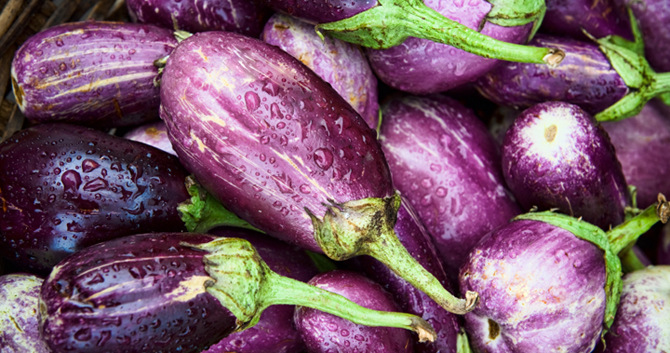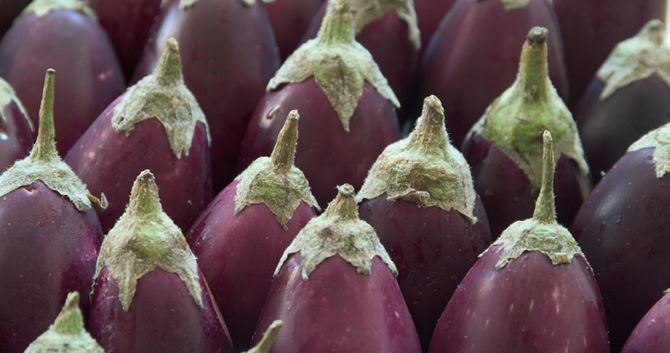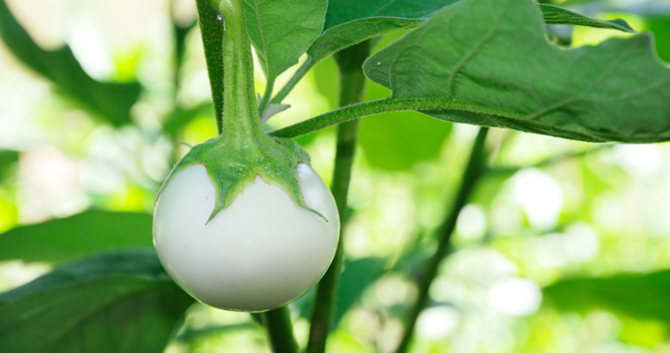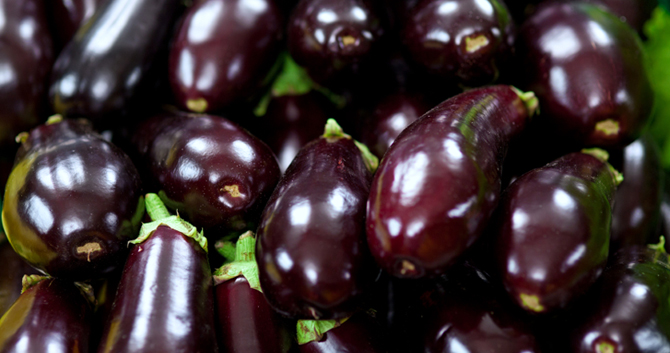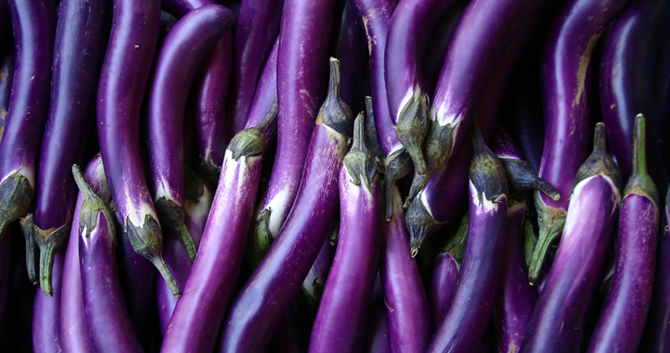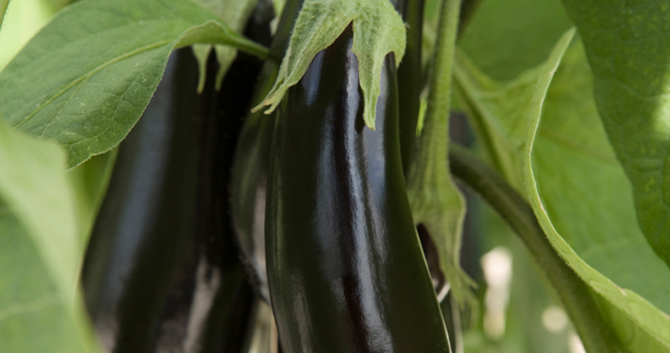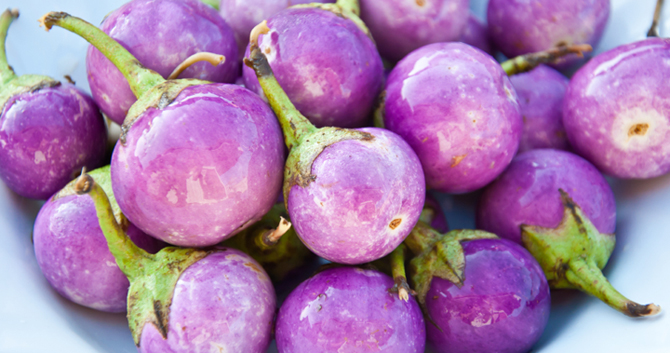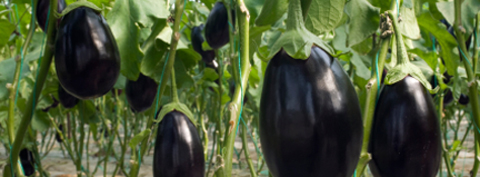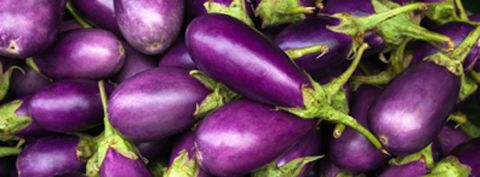 Eggplant's pleasantly bitter taste is a delicious addition to any meal.
Eggplant's pleasantly bitter taste is a delicious addition to any meal.
Eggplant has earned its place in the garden as well as the dinner table! Popular in Greek, Italian, and Turkish cuisine for centuries, its delicious marinated, grilled, roasted, fried, or stuffed. This versatile vegetable is used in main dishes, casseroles, stir-fries, dips, and side dishes and is a favorite among vegetarians.
Eggplant has a mildly bitter taste that balances other flavors. It pairs well with Mediterranean flavors like basil, oregano, bay leaves, parsley, and garlic as well as classic French herbs like sage, thyme, and marjoram.
History:
Native to India and Pakistan, ancient Sanskrit documents are rich with references to eggplant. In fact, its scientific name (Solanum melongena) was derived from Arabic! Wild eggplant is a thorny plant with small, white, round fruit resembling eggs (hence its common name). Originally grown for medicinal uses, early Chinese botanists transformed it into the smooth, purple, teardrop-shaped fruit we know today.
Arab traders introduced eggplant to Europe in the 16th century as a love potion - embraced by the Spanish and nicknamed “Love Apples”, eggplant was shunned by superstitious Northern Europeans who called them "Mad Apples", believing consuming eggplant drove you insane.
Thomas Jefferson, an avid horticulturist, brought eggplant to the United States after receiving one from a friend in France. They still grow in the gardens of his Monticello home today.
Types:
 Small-fruited, exotic-colored and ornamental varieties can be grown in containers and used for decorations.
Small-fruited, exotic-colored and ornamental varieties can be grown in containers and used for decorations.
Although widely considered a vegetable, eggplant is botanically classified as a fruit. Part of the nightshade family, it’s related to tomatoes, potatoes, and peppers. Most gardeners are familiar with the standard eggplant, but may not be aware of the wide assortment of heirloom varieties available - round and fat or long and thin, they can be as small as an egg or as large as a melon.
Beyond dark purple or original white, there are also lavender, orange, green, pink, and multi-colored varieties to choose from. Look for heirloom varieties at the garden center and explore the possibilities!
Getting Started:
Eggplants are very versatile in the garden - both decorative and delicious they work well in containers, flower borders, raised garden beds and traditional garden plots. Pretty bell-shaped lavender flowers, soft velvety foliage, and contrasting deep purple stems are an extra bonus, helping eggplant add a decorative touch to the home garden, particularly in containers where they can be used as a focal point and paired with other flowers.
Eggplant is the ideal summer crop, thriving in heat, humidity, and sunlight. During the peak of summer eggplant comes into its own, growing quickly and producing vigorously. Conversely, it's very sensitive to the cold so be sure to wait until the all threat of frost has passed before planting. They like full sun and warm soil so be sure to select a site where they will get sun most of the day. A few weeks before planting, it helps to warm the soil by covering it with black plastic – this encourages an earlier harvest and greater yield.
Before planting, remove debris and loosen the soil, breaking up any clumps that are larger than an apple. Add 2-4 inches of compost or other organic garden mix to encourage root growth for a healthy plant.
Care Tips:
With these simple care tips, you’ll maximize the yield and enjoy fresh, lush eggplant from July until the weather cools in early fall.
Planting: Eggplants are large plants that need room to grow. Leave a good two feet between plants to avoid overcrowding. Rows should be spaced about three feet apart.
Watering: Keep plants well-watered or the fruit will be small and bitter. Water regularly during the summer to keep the soil consistently moist, especially during hot dry periods.
Mulching: Add organic mulch to retain moisture and keep down weeds.
Fertilizing: Apply a fertilizer high in nitrogen about every 4 to 6 weeks during the growing season. Choose a product recommended for vegetables, and follow package directions.
Staking: Plants are tall and can become heavy with fruit so it’s a good idea to stake them for extra support. You can also use small tomato cages to support the plants.
Harvesting:
Eggplants are best harvested young and tender, when their skin is smooth and glossy and seeds are still soft and white. By harvesting early, you won’t need to peel before cooking. Older fruits become dull and brown, with a bitter taste and spongy texture.
 Eggplant can be found in many colors including white, red, purple and green.
Eggplant can be found in many colors including white, red, purple and green.
Size may be misleading in determining ripeness so test the eggplant by gently pressing with your thumb. If it has some give but bounces back, it’s ready to eat; if it’s still hard, the eggplant is immature, too soft and it’s overripe.
Use shears to cut the fruit from the plant as stems can be tough - twisting or pulling can damage the plant. Leave at least an inch of stem attached to the fruit. Even properly harvested fruits do not store well and should be eaten within a few days of picking.
Companion Plants:
Take advantage of plants that grow well with eggplant, deterring pests, improving taste, and beautifying the garden. The following plants are good companions when planted along with eggplant:
- Beans encourage growth by enriching the soil and protecting eggplants from insects.
- All forms of onions, including shallots, leeks, and chives help protect against pests and improve growth and flavor.
- Tarragon, thyme, mints, basil and oregano help eggplant by repelling pests.
- Borage, summer savory and lovage increase yields and improve flavor.
- Marigolds, geraniums and chrysanthemums help deter pests.
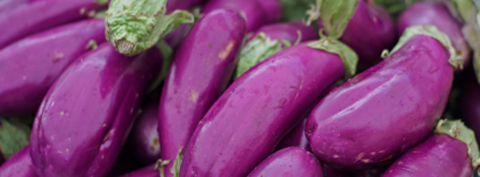 Exotic in taste and texture, eggplant can be prepared in a variety of different ways.
Exotic in taste and texture, eggplant can be prepared in a variety of different ways.
Conversely, there are a number of plants that don’t make good neighbors for eggplant, competing for nutrients or attracting unwanted pests. Steer clear of planting any of the following too close to eggplant:
- Fennel and dill attract pests that will bother eggplant.
- Corn and all types of cole crops (broccoli, cabbage, cauliflower, etc.) don’t grow well with eggplant.
Several edibles share space well with eggplants, using the garden plot to full advantage. Use the space between eggplants to tuck in the following:
- Pole beans and peas will make good use of the space above the larger eggplant plant.
- Lower-growing vegetables and herbs such as bush beans, spinach and thyme will carpet the ground around eggplant and help suppress weeds.

